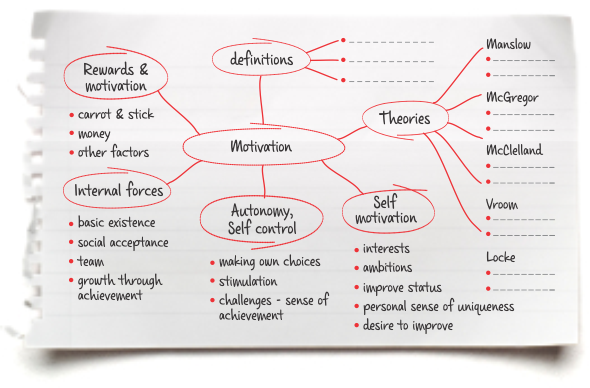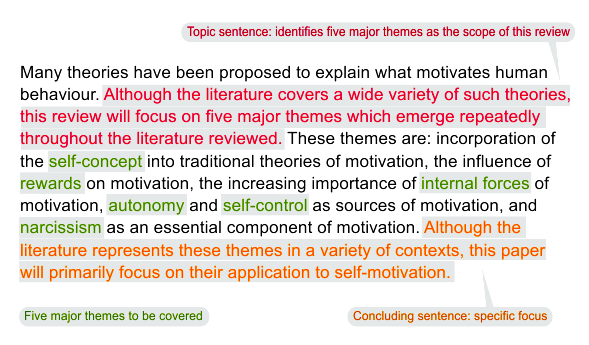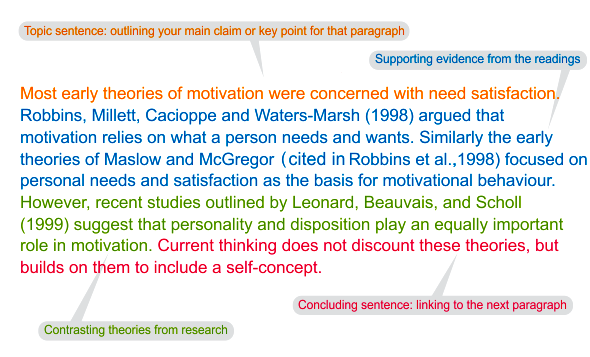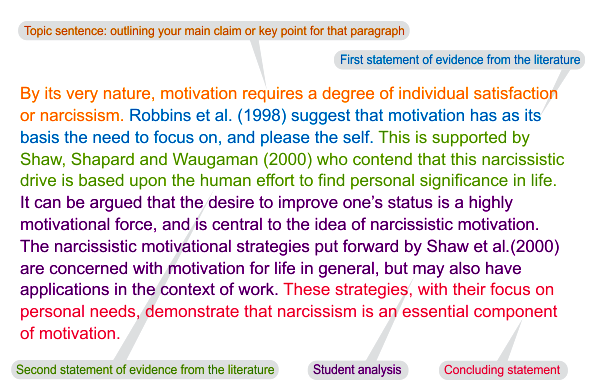Writing
Planning using mind maps
Mind maps are a visual map to link and organise key concepts of your research. They also show links and relationships between ideas. Sometimes it is a good idea to number key ideas in the order that you are going to place them in your literature review.
Example of a mind map
Here is an example of a mind map on motivation:

Motivation
- rewards
- carrot and stick
- money
- other factors
- internal forces
- basic existence
- social acceptance
- team
- growth through achievement
- definitions
- autonomy, self control
- making own choices
- stimulation
- challenges - sense of achievement
- self motivation
- interests
- ambitions
- improve statius
- personal sense of uniqueness
- desire to improve
- theories
- Manslow
- point 1 etc.
- McGregor
- point 2 etc.
- McClelland
- point 3 etc.
- Vroom
- point 4 etc.
- Locke
- point 5
- Manslow
Writing examples
Writing your literature review takes time. You may need to complete several drafts before your final copy. It is important to have a good introduction that clearly tells the reader what the literature will be about.
An introduction must tell the reader the following:
- what you are going to cover in the review
- the scope of your research
- how the review ties in with your own research topic.
This is a good example of an introduction because it has a topic sentence which indicates what will be covered and also tells the reader the specific focus of the literature review in the concluding sentence.

Introduction example
- 'Topic sentence': identifies five major themes as the scope of this review
- 'Theme #': The five major themes to be covered
- 'Concluding sentence': The specific focus
Many theories have been proposed to explain what motivates human behaviour. [Topic sentence: Although the literature covers a wide variety of such theories, this review will focus on five major themes which emerge repeatedly throughout the literature reviewed.] These themes are: incorporation of the [Theme 1: self-concept] into traditional theories of motivation, the influence of [theme 2: rewards] on motivation, the increasing importance of [theme 3: internal forces] of motivation, [theme 4: autonomy and self-control] as sources of motivation, and [theme 5: narcissism] as an essential component of motivation. [Concluding sentence: Although the literature represents these themes in a variety of contexts, this paper will primarily focus on their application to self-motivation.]
Lecturer's comments
Notice how the student has clearly said WHAT she will cover in this review. This is particularly important in a large topic area.
To develop an integrated argument from multiple sources, you need to link your arguments together. The model below is a guide.

Legend
- 'Topic sentence': outlining your main claim or key point for that paragraph
- 'Evidence': supporting evidence from the readings
- 'Contrast': contrasting theories from research
- 'Conclusion': concluding sentence linking to the next paragraph
Paragraph
[Topic sentence: Most early theories of motivation were concerned with need satisfaction.] [Evidence: Robbins, Millett, Cacioppe and Waters-Marsh (1998) argued that motivation relies on what a person needs and wants. Similarly the early theories of Maslow and Mc Gregor (cited in Robbins et al. 1998) focused on personal needs and satisfaction as the basis for motivational behaviour.] [Contrast: However, recent studies outlined by Leonard, Beauvais, and Scholl (1999) suggest that personality and disposition play an equally important role in motivation.] [Conclusion: Current thinking does not discount these theories, but builds on them to include a self-concept.]
It is important to integrate your analysis and interpretation of the literature in your literature review. Read the following paragraph and see how the arguments have been integrated into the paragraph along with student analysis. Analysis is not just student opinion; it needs to be supported by the literature.

Legend
- 'Topic sentence': outlining your main claim or key point for that paragraph
- 'Evidence #': order of statement of evidence from the literature
- 'Analysis': by the student
- 'Conclusion': concluding statement
Paragraph
[Topic sentence: By its very nature, motivation requires a degree of individual satisfaction or narcissism.] [Evidence 1: Robbins et al. (1998) suggest that motivation has as its basis the need to focus on, and please the self.] [Evidence 2: This is supported by Shaw, Shapard and Waugaman (2000) who contend that this narcissistic drive is based upon the human effort to find personal significance in life.] [Analysis: It can be argued that the desire to improve one's status is a highly motivational force, and is central to the idea of narcissistic motivation. The narcissistic motivational strategies put forward by Shaw et al. (2000) are concerned with motivation for life in general, but may also have applications in the context of work.] [Conclusion: These strategies, with their focus on personal needs, demonstrate that narcissism is an essential component of motivation.]
Most early theories of motivation were concerned with need satisfaction. Robbins, Millett, Cacioppe, and Waters-Marsh (1998) argue that motivation relies on what a person needs and wants. Similarly the early theories of Maslow and McGregor (cited in Robbins et al., 1998) focused on personal needs satisfaction as the basis for motivational behaviour. However, recent studies outlined by Leonard, Beauvais and Scholl (1999) suggest that personality and disposition play an equally important role in motivation. Current thinking does not discount theories, but simply builds on them to include a self-concept.
